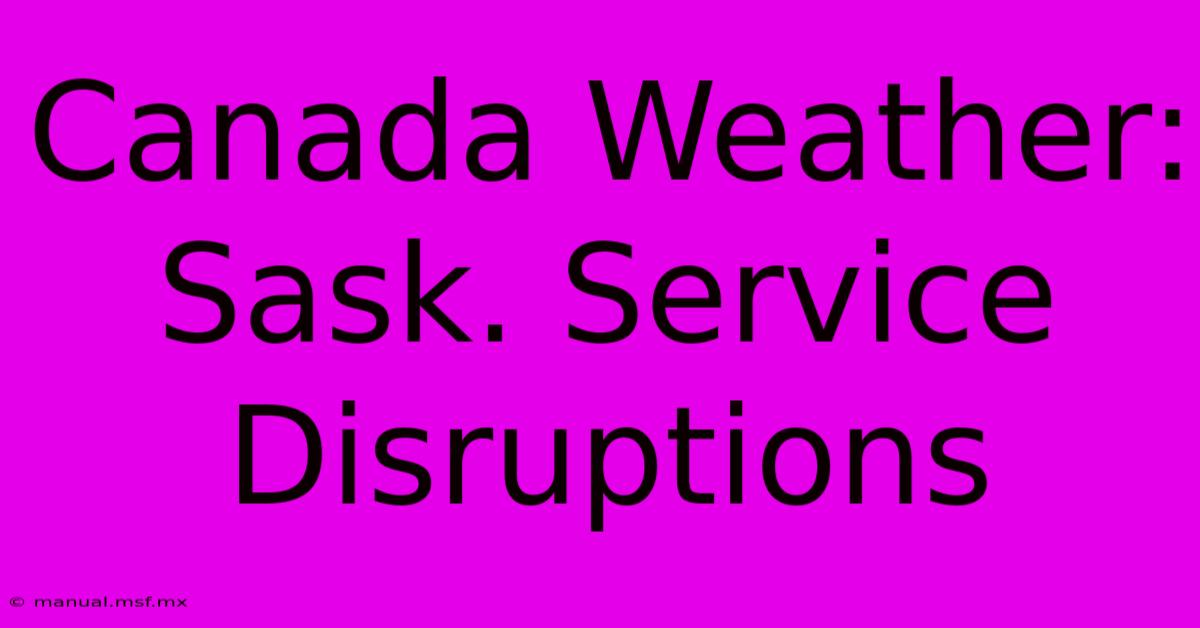Canada Weather: Sask. Service Disruptions

Discover more detailed and exciting information on our website. Click the link below to start your adventure: Visit Best Website. Don't miss out!
Table of Contents
Canada Weather: Sask. Service Disruptions - Extreme Cold Grips the Prairies
Is a "Saskatchewan winter" synonymous with extreme cold and service disruptions? The answer is a resounding yes, as this province often faces challenges with extreme weather, particularly during the winter months. Editor Note: Saskatchewan has experienced a severe cold snap, impacting services across the province.
Understanding the impact of winter weather on Saskatchewan's infrastructure and daily life is crucial. This article delves into the recent service disruptions caused by extreme cold, highlighting key aspects like transportation, power outages, and social services.
Our Analysis: This comprehensive review examines Saskatchewan's recent winter weather event, exploring the effects on vital services. We analyzed data from official sources, including weather reports, news articles, and government statements, to provide an in-depth analysis.
Key Takeaways from Saskatchewan's Cold Snap:
| Aspect | Description |
|---|---|
| Transportation Impacts | Road closures, flight delays, and disruptions to public transportation systems. |
| Power Outages | Blackouts and reduced power supply due to extreme weather conditions on power grids. |
| Social Service Disruptions | Challenges in accessing essential services, like healthcare and emergency response. |
Transportation Impacts:
Winter storms are a significant challenge for transportation in Saskatchewan, often leading to:
- Road Closures: Extreme cold can create hazardous driving conditions, prompting road closures for safety reasons.
- Flight Delays and Cancellations: Low visibility and icy conditions can impact air travel, leading to delays and cancellations.
- Public Transportation Disruptions: Bus and train services can face delays or cancellations due to extreme weather.
Power Outages:
Saskatchewan's vastness and reliance on electricity for heating and other services make it vulnerable to power outages during extreme cold.
- High Energy Demand: Colder temperatures increase the demand for energy, potentially overwhelming the power grid.
- Equipment Failure: Extreme cold can damage power lines and equipment, leading to outages.
Social Service Disruptions:
Extreme weather can strain essential social services, impacting the accessibility and effectiveness of:
- Healthcare: Emergency response times can be delayed due to road closures, and healthcare facilities may face staffing challenges.
- Emergency Services: Access to emergency services like police, fire, and ambulance can be hampered by challenging weather conditions.
FAQ:
Q: How do I stay informed about weather warnings and service disruptions?
A: Monitor official sources like Environment Canada, local news, and government websites for updates.
Q: What should I do if I experience a power outage?
A: Be prepared with alternative heating sources, emergency supplies, and a plan for staying safe.
Q: Are there any resources available to help those impacted by the cold weather?
A: Several organizations, including the Red Cross and local charities, provide assistance to those affected by extreme weather.
Tips for Staying Safe During Extreme Cold:
- Dress in layers and wear appropriate winter gear.
- Limit time outdoors and avoid strenuous activity.
- Be aware of frostbite and hypothermia signs.
- Check on elderly neighbors and those who might be vulnerable.
Summary:
Saskatchewan's recent cold snap has highlighted the province's vulnerability to extreme weather. Disruptions in transportation, power, and social services have underscored the importance of preparedness and understanding the challenges posed by severe winter conditions.
Closing Message:
The impact of extreme weather in Saskatchewan emphasizes the need for resilient infrastructure and effective response systems. As climate change continues to influence weather patterns, communities must adapt and collaborate to mitigate the effects of severe winter conditions.

Thank you for visiting our website wich cover about Canada Weather: Sask. Service Disruptions . We hope the information provided has been useful to you. Feel free to contact us if you have any questions or need further assistance. See you next time and dont miss to bookmark.
Also read the following articles
| Article Title | Date |
|---|---|
| Tyson Vs Paul Fight Stats Analysis | Nov 14, 2024 |
| Carton Rouge Au Port 3e Edition Contre Les Violences | Nov 14, 2024 |
| Hapag Lloyd Neubauprogramm Hamburg Baut Flotte Aus | Nov 14, 2024 |
| Tulsi Gabbard Former Democrat Now What | Nov 14, 2024 |
| Wembanyama Defi Ce Soir A 2h | Nov 14, 2024 |
| Onde Assistir Flamengo X Atletico Mg Horario Do Brasileirao | Nov 14, 2024 |
| Channing Tatums Goatee Goes Viral | Nov 14, 2024 |
| Trump Picks Gaetz For Role Senators Baffled | Nov 14, 2024 |
| Tyson Vs Paul Direct Heure Chaine | Nov 14, 2024 |
| Cava Group Stock Surge Whats Driving It | Nov 14, 2024 |
